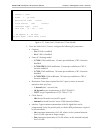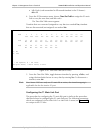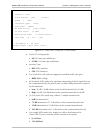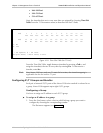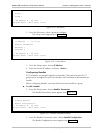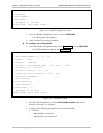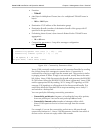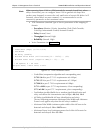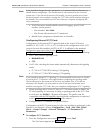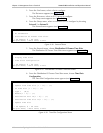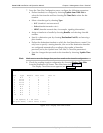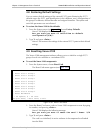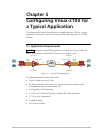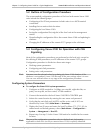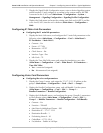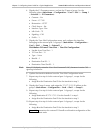
Vmux-2100 Installation and Operation Manual Chapter 4 Management from a Terminal
Configuring Main Link and Voice E1/T1 Ports 4-29
If you intend to change the voice parameters, it is recommended to disconnect a
bundle before configuring it. The bundle must be disconnected at the local and
remote sites. If you do not disconnect the bundle, you must perform reset of the
local and remote voice modules carrying the E1/T1 links which timeslots belong to
the bundle. The voice modules must be reset after you complete configuring the
voice parameters.
VLAN Parameters (enable/disable virtual LAN tagging, specify VLAN
number, and its priority):
Vlan Number: 26 to 4094
Vlan Priority: 0 (minimum) to 7 (maximum).
Bundle Name (assigning an identification to a bundle).
Configuring External E1/T1 Ports
Configuration of the external E1/T1 ports located on the Vmux-2100 voice
modules (V-2E1, V-4E1, V-2T1, V-4T1) is similar to the configuration of the E1/T1
ports of the main link modules (M-IPE1, M-IPT1). In addition to the standard
configuration procedures listed in the Configuring the E1 Main Link Port and
Configuring the T1 Main Link Port sections above, you must perform the following:
• For T1 links, select a signaling mode:
Robbed Bit MF
CCS.
• For E1 links, selecting the frame mode automatically determines the signaling
mode:
G.732S or G.732S-CRC4 framing: CAS signaling
G.732N or G.732N-CRC4 framing: CCS signaling.
If you intend to change E1/T1 signaling, it is recommended to disconnect a bundle,
to which the E1/T1 timeslots are assigned before configuring the signaling mode.
The bundle must be disconnected at the local and remote sites. If you do not
disconnect the bundle, you must perform reset of the local and remote voice
modules carrying the E1/T1 links after you complete configuring the E1/T1 signaling.
• When operating with CAS (for E1 links in G.732S frame modes) or RBMF (for
T1 links) signaling, it is necessary to assign a signaling profile to the E1/T1 link.
In such cases the Profile[1 - 5] option will appear. The profile must be
compatible with the PBX signaling (signaling profile configuration is explained
in the Configuring Signaling Information section above).
• Configure the E1/T1 timeslots, as explained below.
Configuration of the E1/T1 ports located on the voice modules is performed via the
External 1 and External 2 menus (Configuration > Card >Slot 1/Slot 2/Slot3/
Slot 4 > Group 1/Group2 > External 1/External 2 > E1 Parameters/T1
Parameters).
To configure E1/T1 timeslots:
1. From the Configuration menu (see Figure 4-4), choose Card.
The Card menu appears (see Figure 4-21).
Note
Note



